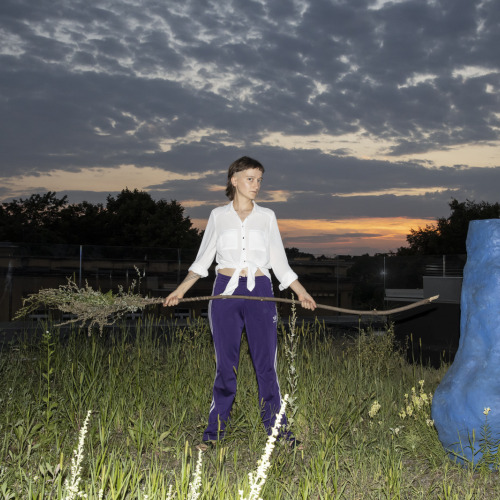
Europe, Views from the Sidelines
In addition to Aleksandra Vajd’s non-curatorial,
artist-initiated selection of images by contemporary young European
photographers and the urban comix interventions chosen by strip-expert Igor
Prassel, City of Women presents a number of installations and single-channel
videos. Directly or indirectly, subtly or overtly, ironically or passionately,
these works seek to challenge unifying, all-encompassing notions about the
homogeneity of Europe’s collective values and identity.
If
You Could Speak Swedish… - Esra Ersen
For a commission by Stockholm’s Moderna Museet, the Istanbul-based artist Esra Ersen took her
camera to the suburbs of the Swedish capital to talk to foreigners and refugees
enrolled in a Swedish language program. She asked them to write down, in their
native language, what they would say if they could speak fluent Swedish. The
students were free to choose whatever subject they wanted, and their answers –
in Chinese, Arabic, Russian, Spanish, and Bengali, as well as other languages
–range from personal, emotional comments to political statements. These were
then translated into Swedish, and the students, with the help of a teacher,
read their statements in Swedish in front of Esra’s camera. Their facial
expressions, gestures, and intonation supplement – and modify – the meaning of
the words they speak. The ease and fluency with which the students deliver
their comments in their native languages contrasts starkly with the difficulty
they experience when speaking their ‘new’ language.
Esra Ersen is interested in how identities are formed and re-formed, and much
of her work is anchored in her own Turkish background. She does not shrink from
social, political or private elements as she investigates how meaning is
created and (mis)understood. Often site-specific, her works include
photography, video, and installation.
http://www.fridericianum-kassel.de/ausst/balkan03/kuenstler/19.html
http://www.artfacts.net/index.php/pageType/artistInfo/artist/3611
Els
Segadors - Coco Fusco
You may remember performance artist Coco Fusco as an Undiscovered Amerindian in The Couple in the Cage,
or as someone in search of The Incredible Disappearing Women. Those who attended
last year’s City of Women Festival will not have forgot the particular brand of
irony and humour displayed in her ‘deconstructive parodies’, which examine the
cross-cultural reshaping of individual and community identities. The hilarious
single-channel video-installation Els Segadors, one of her most recent works,
displays the same sense of irony, as Fusco tackles the question of Catalan
national identity, which today is as controversial an issue as ever.
Els Segadors premiered at the Museum Boijmans Van Beuningen in Rotterdam as
part of the Unpacking Europe exhibition (last year’s City of Women Festival
visitors had the chance to see preview clips of the work). As Els Segadors
relates in many ways to this year’s festival program – and was one of the
inspirations behind it – City of Women is delighted to host the full-length
version of the video.
When Coco Fusco decided to create a work on the glaring disparity between the
official version of national identity and the reality it is meant to reflect,
and chose Catalonia’s national anthem ‘Els Segadors’ as her starting point, she
hit the mark. One month before she arrived in Barcelona to make the video, the
regional Department of Education – in the midst of mounting anxiety over the
impact of immigration on Catalan social integrity – adopted a resolution requiring
all primary and high school children in Catalonia to learn ‘Els Segadors’.
During the same period, the wife of Jordi Pujol, the president of Catalonia’s
regional government, made xenophobic public statements claiming that the
national culture was being threatened by immigrant children speaking languages
other than Catalan.
‘Fusco’s video documentary stresses the absurdity lying behind any attempt at
forcibly articulating the identity of a country. … A Catalan girl of Andalusian
descent may sing Els Segadors to a Sevillanas rhythm, or an Anglo-Pakistani
will declare the music does not appeal to him, and thus proceed to adapt it to
his own liking. These “irreverent” responses are, in fact, the only possible
way to adapt to an imposed cultural pattern. In the process Els Segadors aptly
becomes ‘other’ than it is meant to be by the official guardians of Catalan
national identity. (…) Coco Fusco's work … fills one of Europe's most ancient
ghosts – the nightmarish dream of a homogeneous, ideally eternal, unaltered
cultural essence – with the invigorating “presence of the now”. At a time when
Europe must either accept the “other” cultures which live on its soil, or
condemn itself to sing old vengeful patriotic anthems.’ (Ana Nuño, Unpacking
Europe catalogue)
(For more on Coco Fusco, check out: http://www.thing.net/~cocofusco)
Passing
Drama - Angela Melitopoulos
‘The video Passing
Drama is based on various recollections of refugees. Drama is
the name of a small city in Northern Greece. But as a common noun in the Greek
language, it can be translated as “scene”. It can also mean “narration” or
“play”. The city of Drama was populated by many refugees (including my
grandparents) who survived the deportations from Asia Minor to Greece in 1923.
During World War II, their children escaped the Bulgarian occupation only to
become worker-slaves in Hitler's Germany (Germany and Bulgaria were allies).
Interviews with these refugees, linked with my father’s recitation of his move
from Greece to Vienna, follow a diagonal trajectory through Europe, crossing
four different national states.
‘The territory of the “refugee” is continuously changing. His or her memories
are re-mixed depending on the conditions of integration. The history of
refugees is passed orally from one generation to the next. Recorded interviews
with refugees within the boundaries of Drama form the voice level in the
“woven” editing structure of this video. To tell a story that has been
transmitted, retold, and re-memorised from one generation to the next, means to
reflect on the subject of narration itself. Storytelling implies the recall of
memories. Consequently, we have to pass through different densities of
constructive or superfluous “thought-flows”. During this process we connect our
own words with the generated word-constructions of others.
‘The voices are like invisible threads in the woven structure of this video. As
in a carpet, one can see the knots on the front side, but it is only by looking
at the back of the carpet that one can follow the threads connecting the knots.
‘Passing Drama is edited as a hypertextual structure of image and sound, a
structure of memory and recollection visualised through non-linear editing.
Passing Drama tells its story from the point of view of a minority whose past
seems to be devoured by industrial machines favouring the majority.’ –(Angela
Melitopoulos)
http://i-space.org/index.php?page=74
Dual(national)ity
- Tanya Ury
In 1999, the German government distributed a series of postcards announcing the
new German citizenship laws that would come into force in the year 2000. On one
of the cards you see a ‘Korean’ women with her ‘German’ boyfriend. Now, with
the new legislation – according to the message on the card – she can obtain the
same rights he already enjoys. Welcome to the bright new multicultural Germany.
Dual(national)ity,
a series of visuals and texts by Tanya Ury, tells a different story…
Dual(national)ity is but one example of Tanya Ury’s multiple artistic practice,
which is located at the interface of visual art, performance and storytelling.
Her works, which include video, photography, narrative performance, and
literary reflections, investigate the imprint of history and identity
constructions and echo a chaotic and fragmented chorus of divergent artistic,
cultural, theoretical, and political voices that influence and deform each
other.
http://www.tanyaury.com
Die
leere Mitte – Hito Steyerl
Die leere Mitte
[The Empty Centre], a documentary film essay by writer and director Hito Steyerl,
reveals the layers of history beneath the construction site at Potsdamer Platz
in Berlin.
Before World War II, Potsdamer Platz was the lively centre of Berlin, and the
centre of power. During the Cold War, it became an empty minefield, sandwiched
between the East and West parts of the city, demarcated by the Berlin Wall.
After 1989, when the Wall fell, the death strip, the empty margins on each side
of the former border, once again became accessible. The centre returned.
Using dissolves of archival material and present-day images, the film engages
the viewer in an archaeology of the present. On the spot where the philosopher
Moses Mendelssohn – the grandfather of composer Felix Mendelssohn – was once
prevented by customs officers at the former gate from entering the city because
he was Jewish, today a woman from Jamaica, herself a temporary resident in
Germany, sells pieces of the Wall and old East German transit visas as
souvenirs.
Where in 1884 the colonial powers designed the internal borders of Africa
(later known as “the Berlin Borders”) and where the Berlin Conference
established the borders of the Balkan states (with the goal of ensuring Western
influence), today East European migrant workers construct the headquarters of
multinational corporations, such as Mercedes Benz and Sony. But as part of the
same process, people are being shoved to the outskirts of the city,
marginalised by the re-centring of Germany’s political and economic power.
Through its focus on Potsdamer Platz, the film discovers the residue of global
power shifts and the simultaneous dismantling and reconstruction of borders. At
the same time, it uncovers a history of the racism and exclusion – especially
against immigrants and minorities – that have always served to define the
notion of the powerful national centre.
http://subsol.c3.hu/subsol_2/contributors2/steyerlbio.html
http://www.haussite.net/haus.0/PROGRAM/INFO_2001/hito/hito_E.html
Profile
and Trembling Time
- Yael Bartana
Yael Bartana’s work deals with the rituals of social training and the individual’s
role of assimilation within geopolitical contexts. Depicting four minutes of a
target practice session with young female Israeli soldiers, Profile transcends
the mesmerising routine of the loop and skims past such cliché formulations as
‘guns and chicks’ or ‘good and bad’. With headphones on, the viewer watches a
young uniformed woman in profile. Standing in an orderly line with her fellow
soldiers, she (also wearing headphones) carefully, almost mechanically, handles
her weapon: She picks it up, holds it, aims, waits, shoots, and puts it back on
the floor, ready to recommence the routine. Resembling a slow-motion playback
in a sports event, the action repeats itself mercilessly, mirroring the
repetition of reality and the persistence of systems in society. ‘My work’,
says Bartana, ‘investigates the dynamics of the relation between the individual
and the state. As a soldier, it is difficult to keep your personal sovereignty
without actively resisting commands.’ The Israeli-born artist, who now divides
her time between Amsterdam and New York, depicts the complexity of recalling a
collective moment and the ongoing presence of war.
In Trembling Time
(which she presented earlier this year at Manifesta 4), Bartana again confronts
us with the tension between the individual and the threatening
state-orchestrated collective. She filmed this seven-minute sound/video piece
in Tel-Aviv from a highway overpass on Soldiers Memorial Day. It depicts a
moment of silence as it is observed in traffic during a countrywide siren. The
process of stopping and the moments leading up to it, are suspended and
repeated. Traffic slows down, begins to stop, slowly converges, and solidifies.
The result is a dreamlike image, both captivating and disturbingly alienating.
Trembling Time questions the impact of ceremony on society and the individual.
http://www.my-i.com/
Sounds of Soup and Ironing – Maria Chuykova
In the installation
Ironing, Masha, after having properly vacuumed the whole room,
gives her postmodernist books the complete washing, drying, and ironing
treatment. (Didn't Godard once say, ‘Paris is dirty’ so ‘people should wash
their ideas’?)
In Sounds of Soup she
exhibits seven saucepans standing on pedestals made out of contemporary
philosophy classics. Coming out of each pot we hear various sounds of the
‘production process’: boiling water, vegetables being chopped, the hissing of
frying vegetables, etc.
For the opening of the 8th City of Women Festival, Maria Chuykova – also known
as the ‘Widely Read Housewife’ – will treat us to some Slavic food for the
soul, as well as food for the body.
http://www.tvgallery.ru/en/articles/article_147.html
Programme
Installations:
Mednarodni grafični likovni center – MGLC, 7.10. – 19.10. 2002
Sre.-ned. / Wed -Sun.: 11.00-18.00
and exceptionally on 8. 10..: 11am - 6pm
Performance:
Mednarodni grafični likovni center
Mon., 7 Oct., 8:30 p.m.:
Sounds of Soup,
Maria Chuykova
Tue., 8 Oct., 4 p.m.-6 p.m.:
Ironing,
Maria Chuykova
Film screenings:
Slovenska kinoteka
Thu., 17 Oct., at 7 p.m.:
Passing Drama
- Angela Melitopoulos
at 8:30 p.m.:
If You Could Speak
Swedish… Esra Ersen
Els Segadors – Coco Fusco
at 10 p.m.:
Die leere Mitte [The
Empty Centre] Hito Steyerl
Broadcast on TV Slovenia 1 in the arts programme Terminal:
2. oktobra ob 22:55 :
Passing Drama
Angela Melitopoulos
Profile
– Yael Bartana
In cooperation with: Mednarodni grafični likovni center
With the support of: Cultural Link Program (OSI-Budapest), SCCA-LJUBLJANA Zavod
za sodobne umetnosti / Center for Contemporary Arts


